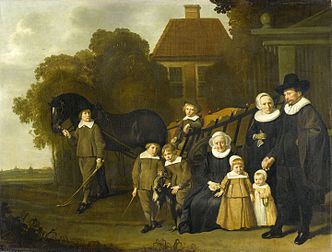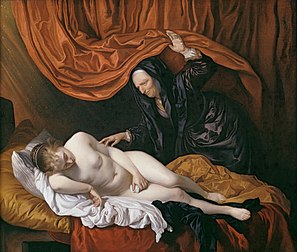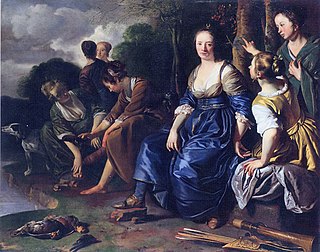
Baroque painting is the painting associated with the Baroque cultural movement. The movement is often identified with Absolutism, the Counter Reformation and Catholic Revival, but the existence of important Baroque art and architecture in non-absolutist and Protestant states throughout Western Europe underscores its widespread popularity.
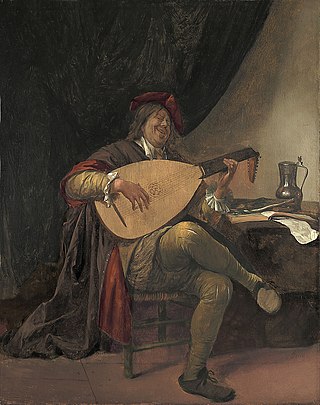
Jan Havickszoon Steen was a Dutch Golden Age painter, one of the leading genre painters of the 17th century. His works are known for their psychological insight, sense of humour and abundance of colour.

GovertTeuniszoon Flinck was a Dutch painter of the Dutch Golden Age.
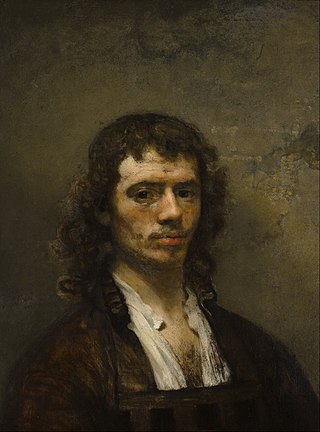
Carel Pietersz. Fabritius was a Dutch painter. He was a pupil of Rembrandt and worked in his studio in Amsterdam. Fabritius, who was a member of the Delft School, developed his own artistic style and experimented with perspective and lighting. Among his works are A View of Delft, The Goldfinch (1654), and The Sentry (1654).
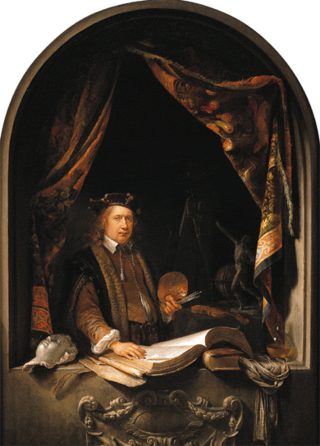
Gerrit Dou, also known as GerardDouw or Dow, was a Dutch Golden Age painter, whose small, highly polished paintings are typical of the Leiden fijnschilders. He specialised in genre scenes and is noted for his trompe-l'œil "niche" paintings and candlelit night-scenes with strong chiaroscuro. He was a student of Rembrandt.

Nicolaes Maes was a Dutch painter known for his genre scenes, portraits, religious compositions and the occasional still life. A pupil of Rembrandt in Amsterdam, he returned to work in his native city of Dordrecht for 20 years. In the latter part of his career he returned to Amsterdam where he became the leading portrait painter of his time. Maes contributed to the development of genre painting in the Netherlands and was the most prominent portrait painter working in Amsterdam in the final three decades of the 17th century.

Bartholomeus van der Helst was a Dutch painter. Considered to be one of the leading portrait painters of the Dutch Golden Age, his elegant portraits gained him the patronage of Amsterdam's elite as well as the Stadtholder's circle. Besides portraits, van der Helst painted a few genre pictures as well as some biblical scenes and mythological subjects.
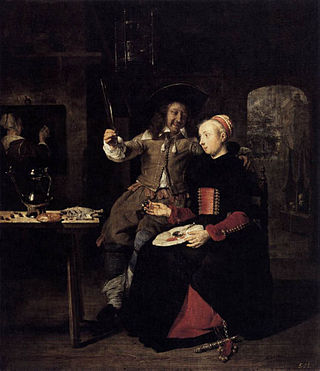
Gabriël Metsu (1629–1667) was a Dutch painter of history paintings, still lifes, portraits, and genre works. He was "a highly eclectic artist, who did not adhere to a consistent style, technique, or one type of subject for long periods". Only 14 of his 133 works are dated.

Eglon van der Neer was a Dutch painter of historical scenes, portraits and elegant, fashionable people, and later of landscapes.

Rembrandt Harmenszoon van Rijn, usually simply known as Rembrandt, was a Dutch Golden Age painter, printmaker, and draughtsman. He is generally considered one of the greatest visual artists in the history of Western art. It is estimated Rembrandt produced a total of about three hundred paintings, three hundred etchings, and two thousand drawings.

Frans Banninck Cocq, free lord of Purmerland and Ilpendam was a knight, burgemeester (mayor) and military person of Amsterdam in the mid-17th century, the Dutch Golden Age. He belonged to the wealthy and powerful Dutch patriciate, the regenten, and is best known as the central figure in Rembrandt's masterpiece The Night Watch.

Hendrickje Stoffels was the longtime partner of Rembrandt. The couple were unable to marry because of the financial settlement linked to the will of Rembrandt's deceased wife Saskia, but they remained together until Hendrickje's death. In 1654 she gave birth to Rembrandt's daughter Cornelia. In the later years of their relationship Hendrickje managed Rembrandt's business affairs together with the painter's son Titus.

Jan Jacobszoon Hinlopen was a rich Dutch cloth merchant, an officer in the civic guard, a real estate developer in the Jordaan, alderman in the city council and a keen art collector. He would have been elected as a burgomaster, if he had not died at the age of forty, an age considered acceptable to be eligible. He was a prominent patron of the arts in his time, and there is some speculation on being an influential protector of Rembrandt and it is likely that he had good connections with Gabriel Metsu. Hinlopen, like his father-in-law, Joan Huydecoper I, is known in art history because of the poems by Jan Vos reciting the paintings in his house and members of the family. These paintings are spread all over the world, the poems nearly forgotten.

Jürgen Ovens, also known as Georg, or Jurriaen Ovens whilst in the Netherlands, was a portrait painter and art-dealer from North Frisia and, according to Arnold Houbraken, a pupil of Rembrandt. He is best known for his painting in the city hall of Amsterdam and paintings for the Dukes of Holstein-Gottorp for whom he worked for more than 30 years, also as an art dealer.
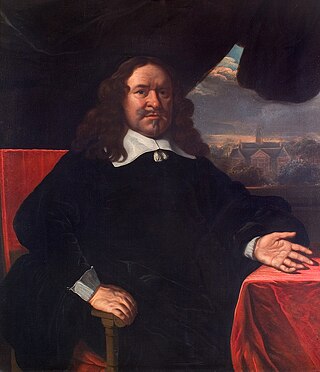
Joan or Johan Huydecoper van Maarsseveen, knighted lord of Maarsseveen, was an important merchant, financial expert, property developer active in Amsterdam and a director of the Dutch East India Company during the Dutch Golden Age. The republican minded Huydecoper was an influential member of the Dutch States Party, diplomat and six times mayor of Amsterdam. He was together with Cornelis de Graeff one of the initiators of the construction of the new town hall of Amsterdam and was a prominent patron of the arts and art collector. Beside Maarsseveen he held the feudal titles of Neerdijk, Thamen and Blockland. Huydecoper is representative of the love of art, political influence and welfare in the Golden Age.

Lucia Wijbrants or Wybrants was the daughter of Johannes Wijbrants, a silk merchant, whose ancestors had moved from Stavoren to Antwerp. After 1585 when Antwerp was occupied by the Spanish army, the family moved to Amsterdam and lived in a house in the Warmoesstraat, then a fashionable shopping street. They had eight more children: only Hendrick (1623–1669), Helena (1628–1721), and Johannes survived.

Jan Abrahamsz Beerstraaten or Johannes was a Dutch painter of marine art, particularly of events of the First Anglo-Dutch War and Dutch-Swedish War. Van Beerstraten depicted ports (Civitavecchia) and cityscapes of Amsterdam, as well as many cities and villages in the Netherlands. He captured castles, churches and other buildings that no longer exist.
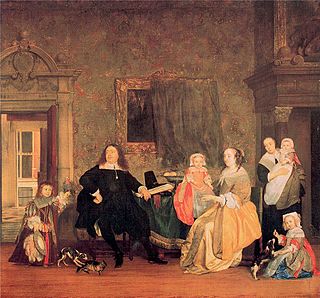
The Portrait of the Family Hinlopen or Family of burgomaster Gillis Valckenier is a painting Dutch Golden Age painter Gabriël Metsu made c. 1663. It is part of the collection in the Gemäldegalerie, Berlin. There have been various ideas among art historians as to which family is actually represented, with the two main candidates being the families of Jan J. Hinlopen or Gillis Valckenier, both wealthy and powerful figures in Amsterdam at the time.

Diana and Her Companions is a painting by Dutch artist Johannes Vermeer completed in the early to mid-1650s, now at the Mauritshuis museum in The Hague. Although the exact year is unknown, the work may be the earliest painting of the artist still extant, with some art historians placing it before Christ in the House of Martha and Mary and some after.


